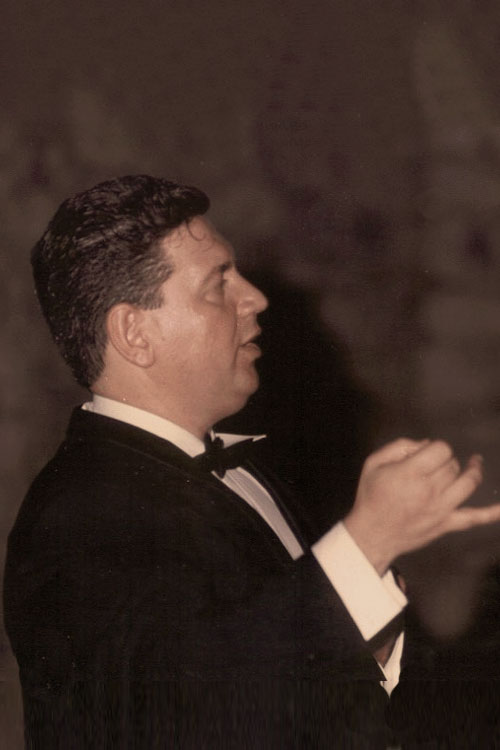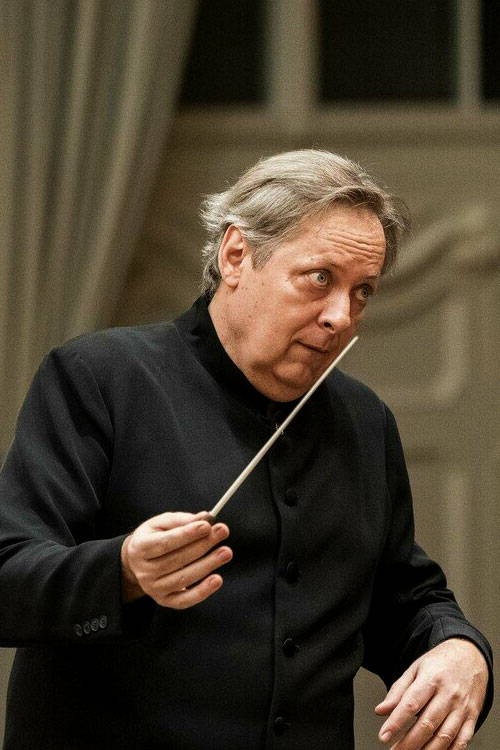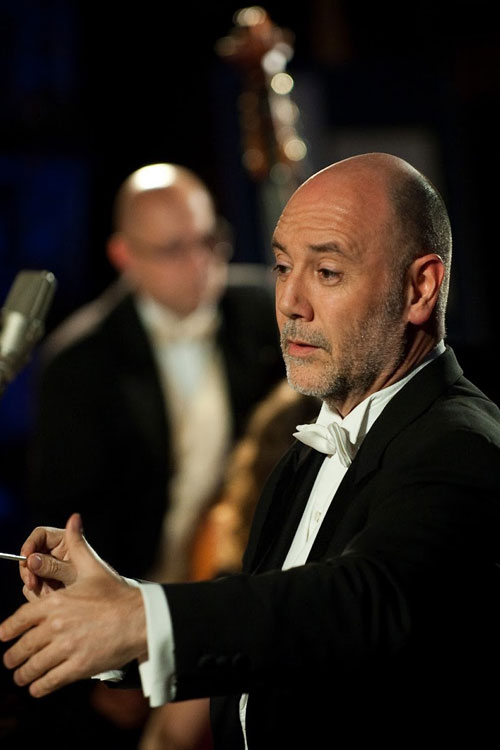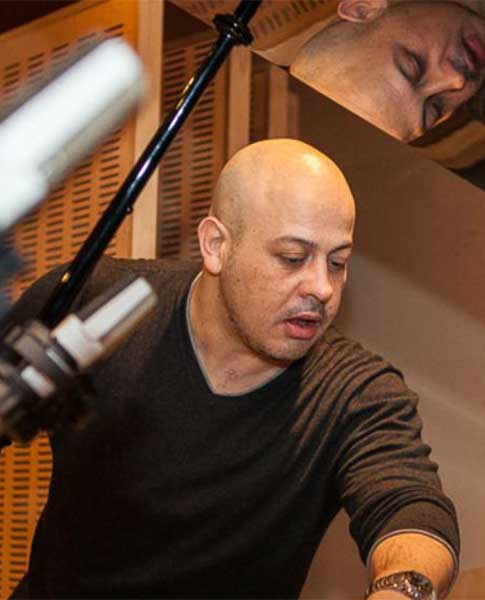Tag: Maestro
Gorka Sierra
Ecumenicon is a work of value, without pretensions. It is extensive, original, a whole concept, not just an idea. The themes Ecumenism and Peace have never been as up-to-date and crucial as they are today. Therefore, the choice of topic and that of the texts supporting it is excellent.
On the other hand, the originality is also presented in the choice of the performers: choir of a combination of voices, a soloist, a recite, a group of percussionists that transform the work into something unique in its genre. However, the originality reaches even further and is perceived in the processing and variety of the rhythms applied and the modal character of harmony. It is a modern piece but it pleases the ear and is interesting to listen to.
I believe that both for the reason of the choice of topic and of its transfer to pentagram, Ecumenicon is a work of art worth of a splendid future, its presentation raised the curiosity and the approval of the audience.
We really hope that Yuri Chuguyev will provide us with more works as finely outlined and of an imagination as subtle as that of this present work.
Gorka Sierra
Composer, Director of ‘Coral de Bilbao’ Society
Peter Feranec
I have known the composer Yuri Chuguyev for decades as a talented musician and a promising composer whose work focuses on themes of global significance.
His compositions have been performed at various forums, concerts, and festivals, where they have been warmly received by both critics and audiences. A distinctive feature of Yuri Chuguyev’s music is its orchestral richness and diversity. His work is also notable for its rhythmic variety and conceptual inventiveness. He frequently returns to Russian themes and motifs, emphasizing his origins and the traditions of the Russian school of composition.
I consider Yuri to be one of the outstanding contemporary composers and I highly recommend his works for performance.
Respectfully,
Peter Feranec
www.peterferanec.com
Miquel Ortega
In the history of art, there have always been cycles; as of music, a relatively young art, on the one side, we have seen periods of great simplicity and on the other side, ones bearing considerable characteristics of baroque: the two of these almost always alternating. The era of baroque was followed by the classic one, as a natural consequence of the saturation by complicated, contrapuntal works which gave way to a gallant style and a simple accompanying melody. Mozart has demonstrated that simplicity is not the enemy of quality. The 20th century and the beginning of the 21st century offer us a somewhat strange picture. Practically, from 1900 until our times, there has been more diversity of musical styles than from 1500 until 1900. Just a single composer like Stravinsky passed through various changes in style during his long life.
Nowadays, two opposite schools coexist (surely, there are much more but they all could be included into two main streams); one of them is totally atonal and baroque, even over elaborate, and the other one bears great transparency and represents a return to tonality, even to modality. In some occasions, this 2nd school does not exclude atonality but does this in a very different way. Poulenc said that he intended to write the less notes possible, this way attributing to him a return to simplicity. Minimalists of our age belong to this extreme and without trying to question quality; it seems that they are more favoured by the audience (to whom music is actually addressed) than those who reserve atonality without concessions.
In "ECUMENICON", Yuri Chuguyev appears to be near to the minimalists without being excessive. His world of sound is tonal and modal, simple and primitive which in its case should be considered as praise. His style is clear and direct; his command over percussions makes the rhythmic component in his works very important, and the variety of the metrics, of the meters of amalgam (those combining binary and ternary elements) add something attractive to his motives of simples appearances.
In "ECUMENICON", it is worth highlighting the inventiveness of Chuguyev in which cutting down on tools becomes a great virtue. He has learnt this from great masters like Mozart, Verdi or Britten, just to name the three greatest composers of the 18th, 18th and 20th centuries, respectively, who among many, excel in this. In this work, we find passages "to the chapel" of the choir, complete or in sections, instrumental passages (with just three percussionists), colourful solos, with a skilled usage of various instruments passing from melodic moments through lira, vibraphone, marimba and xylophone (instruments of a definite sound) to other purely rhythmic ones with all the variety of the disposable accessories of undetermined sound.
This duality of lyric moments combined with ones of great energy from which the above discussed primitivism emerges, is also characteristic of the choir. These latter moments use consecutive fourths and fifths.
"ECUMENICON" is a religious piece which easily could become to be listed in the repertoire of the beginning of the 21st century.
Miquel Ortega
Composer, orchestra conductor and pianist.
Eneko Vadillo
As always, the master conductor, percussionist and composer Yuri Chuguyev brings us a surprisingly fresh sound. A work that summarizes the main characteristics of this author of such an original language: eclecticism, vitality and communicativeness. The deep aroma of multiculturalism that permeates Málaga is breathed, and impressionist sounds, great orchestral tuttis, delicate moments of subtle refinement, as well as a unique rhythmic appeal resonate in perfect balance, all served in a performance under the direction of the maestro full of strength, firmness, delicacy and detail. The work has been recorded in Bratislava in the studios of the Slovak National Radio and reflects the influence that his land of origin, his adopted land and the creativity of Gaudí have had on the life and work of the Russian musician and director.
It represents an example of the fusion of styles that has given rise to the source of inspiration and results of the extraordinary creations of the Spanish composers Manuel de Falla and Joaquín Turina. The use of classic rhythms from Málaga folklore, but in a rhythmic and textural context contrary to the nature of the rhythm (hemiolias, syncopations, false accents) provide freshness and a renewed vision of what until now we could consider Málaga and folklore "tradition" Andalusian only in the mind of a Malaga native of Russian origin or an adopted Russian from Malaga would such a hodgepodge be possible
Plaza de la Merced begins in a rhapsodic and lyrical atmosphere, expressive picking up the charm of the Malaga square. The hustle and bustle of people is tinged with the charm of such a beautiful Malagueña square. The Andalusian turns are transmuted into harmonized melodic turns in a post-impressionist way. The always game of responses between sections so typical of a maestro with echoes of Ravel's bolero... Solos of bassoon trumpet oboe introduce a theme of Andalusian character interspersed by variations of it with the power of metal, creating an image of what the a beautiful plaza in malagueña is: a mix between bustle and intimacy.
It is followed by a beautiful theme for oboe and strings, in the form of a copla, which a Debussy or Ravel could have written, here in a climate dominated by the subtle ringing of castanets. The piece evolves to even epic situations with harmonizations in triadic parallelism giving the piece a powerful character in its middle sections.
Gracia y esperanza, of a clear inspiration or homage to the Holy Week in Malaga, begins with the ringing of drums that are immediately out of tune, being immediately accompanied by phrases that oscillate between the fanfare in trumpets and the lyrical in wood and strings. after an introduction, the main theme is established, the perceived image is clear. a transmutation of Holy Week, with rich sounds, non-classical melodies but which connect directly with the listener and make us feel a different Holy Week than the one we know, a transmutation. Surprising is the twist that the piece acquires in the middle, festive solemn and threatening at the same time. to return to the almost sacred climate with which the piece began
Flores de Málaga acts as a great lyrical interlude, impregnating all the sound fresco with poetry. Malaga smells of jasmine and orange blossom. Orange and jasmine trees adorn each door of each house or garden. the delicate, intoxicating and sweet harmonies that emerge are collected in the sensual and delicate flute solo with which he introduces this piece. After a fast episode, a beautiful violin solo followed by another even more delicate and exquisite clarinet take over the piece with an ethereal background and refined string tremolos. A musician who intoxicates and seduces like the colors and aromas of Malaga do.
The malagueta and the perchel introduce rhythms and syncopations that avoid classifying this music as a representation or transcription of traditional music (which it is not) original music inspired by the Russian maestro that lets the typical features of a music that is also his, malagueña, emanate. and Andalusian.
The Russian master avoids the temptation to make a lyrical and calm, reflective description of the sea that bathes the Malaga coast, the Alboran Sea. On the contrary, he gives us a sea full of verve, emotion and life. The sea that welcomed the first Tartessians, Carthaginians, Romans and other cultures that have bathed the city of Malaga on its slopes. A melting pot that welcomes, receives and transforms whoever approaches its charms. The same can be seen from this work, the most beautiful musical tribute that could be given to the city of Malaga.
Eneko Vadillo Perez
Professor of Composition, Analysis and Orchestration
of the Royal Conservatory of Music of Madrid





